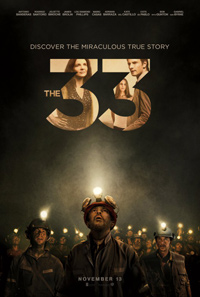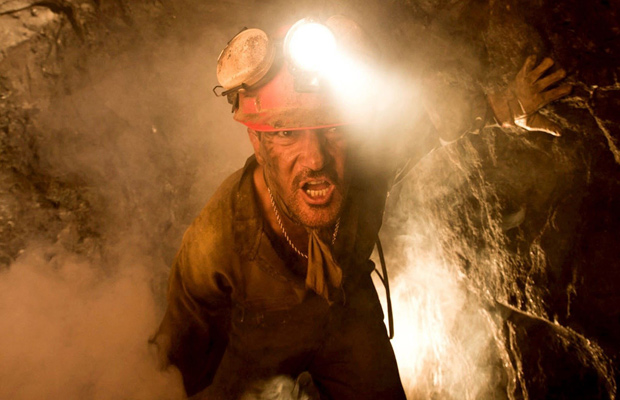Reviews
The 33 | 2015 AFI Film Festival Review
Mountains May Depart: Riggen Reenacts Devastating Chilean Mining Collapse
 Mexican director Patricia Riggen makes a curious departure with her third feature, The 33, a studio backed reenactment of the infamous Chilean mining collapse projected worldwide by the media. The world watched in eerie anticipation as thirty-three men waited patiently to be excavated from the bowels of the earth, stuck for an astounding sixty-nine days together in a mining shelter reservoir with a space allotted for thirty. It was one of the most notable world news headlines in 2010, and with all of the men eventually brought to safety in mid-October, they also provided inspiration for Halloween group themed costumes everywhere. If such a move was moderately silly (or tactless) at the time, this Hollywood treatment seems equally exploitative as it mines for thrills akin to the glut of disaster themed studio extravaganzas of the 1970s. Riggen seems committed to humanizing these men and their families who survived the ordeal, but distracting casting and an unavoidably Anglicized tone seems uncustomary from the director of familial, relationship oriented dramas such as Under the Same Moon (2007) and the Eva Mendes headlined Girl in Progress (2012).
Mexican director Patricia Riggen makes a curious departure with her third feature, The 33, a studio backed reenactment of the infamous Chilean mining collapse projected worldwide by the media. The world watched in eerie anticipation as thirty-three men waited patiently to be excavated from the bowels of the earth, stuck for an astounding sixty-nine days together in a mining shelter reservoir with a space allotted for thirty. It was one of the most notable world news headlines in 2010, and with all of the men eventually brought to safety in mid-October, they also provided inspiration for Halloween group themed costumes everywhere. If such a move was moderately silly (or tactless) at the time, this Hollywood treatment seems equally exploitative as it mines for thrills akin to the glut of disaster themed studio extravaganzas of the 1970s. Riggen seems committed to humanizing these men and their families who survived the ordeal, but distracting casting and an unavoidably Anglicized tone seems uncustomary from the director of familial, relationship oriented dramas such as Under the Same Moon (2007) and the Eva Mendes headlined Girl in Progress (2012).
In August, 2010, a hundred year old Chilean mine collapses upon a team of thirty-three men who remain trapped there for a little over two months’ time. In the panic-stricken early hours of the accident, bureaucratic maneuverings cause a minor delay in providing assistance. A newly appointed minister of mining (Rodrigo Santoro) decides to take the initiative and involve the government, even though the mine is privatized. Eventually, the news story explodes all over the world as a make-shift community gathers near the mining site to await the discovery of their loved ones. Meanwhile, the men must figure out a way to survive. Shift supervisor Don Lucho (Lou Diamond Philips) almost immediately loses hope, while Mario Sepulveda (Antonio Banderas) musters his energy and leadership skills to keep the men positive long enough to survive until help arrives.
With so many characterizations, there’s certainly not enough running time to allocate proper justice to all thirty-three men entombed in the mountainside, and so screenwriters Mikko Alanne, Craig Borten, and Michael Thomas (adapting from Hector Tobars book Deep Down Dark) develop a familiar formula of personality types. However, the only true standouts happen to be the most notable cast members stuck in the muck, Antonio Banderas and Lou Diamond Philips, juxtaposed as two different leadership types.
In retrospect, too much time was devoted to the various family members, all jumbled up into broad stroke characterizations. And though The 33 is honorable, noble, and quite effectively unsettling in its moments of emergency, one can’t help but feel something more innovative and noteworthy would have been accomplished from an actual Chilean perspective. Though whitewashed isn’t the correct term, a variety of Latin performers are cherry-picked to portray the Chilean miners, each forced to speak in accented English. Considering a running dramatic conflict involves one of the men being Bolivian, one wonders why a greater effort wasn’t made for a bit more of the thing we call authenticity, which leads to problems concerning whether or not ‘race’ and ‘ethnicity’ are sacred social constructions worth challenging—though perhaps not in ways where a white, French actress like Juliette Binoche playing an empanada slinging street vendor seems justifiable.
Another conflict would be Irish Gabriel Byrne as Andre Sougarret, a renowned driller, while talented Latin actresses like Kate Del Castillo (who headlined Riggen’s first feature) and Oscar nominee Adriana Barraza get stuck in less worthwhile stock characters with more screen time devoted to Binoche.
The film is one of composer James Horner’s last screen credits before his untimely death, a score that begs us to cherish the folk music underpinning its emotional turmoil, while Riggen collaborates once more with DoP Checco Varese, whose polished work here should certainly enhance his profile.
As a technical piece of work, The 33’s strengths are evident in convincing visuals and Michael Tronick’s editing (no stranger to action sequences considering work on other contemporary disaster film features like Volcano, and some notable moments in this year’s Straight Outta Compton). Though mis-casting abounds and characterizations are thin, the talented cast members do seem to be doing their best considering the parameters they’re working within.
The potential for additional social commentary seems to be desperately avoided, seeing as the second half of The 33 has the potential to mirror Billy Wilder’s 1951 masterpiece of journalistic exploitation, Ace in the Hole. Though it’s Riggen’s greatest platform yet, The 33 isn’t quite as successful as one would hope it to be.
★★/☆☆☆☆☆
Los Angeles based Nicholas Bell is IONCINEMA.com's Chief Film Critic and covers film festivals such as Sundance, Berlin, Cannes and TIFF. He is part of the critic groups on Rotten Tomatoes, The Los Angeles Film Critics Association (LAFCA), the Online Film Critics Society (OFCS) and GALECA. His top 3 for 2021: France (Bruno Dumont), Passing (Rebecca Hall) and Nightmare Alley (Guillermo Del Toro). He was a jury member at the 2019 Cleveland International Film Festival.

































